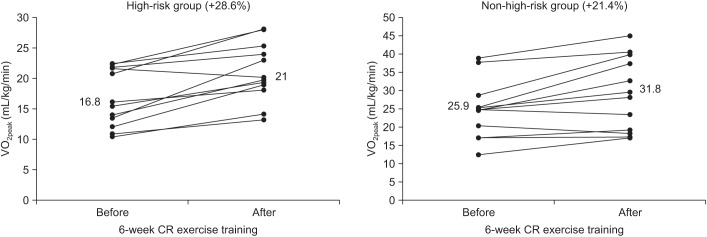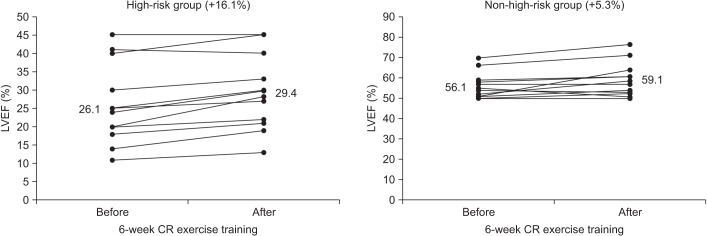Ann Rehabil Med.
2017 Aug;41(4):650-658. 10.5535/arm.2017.41.4.650.
Cardiac Rehabilitation Exercise Training for High-Risk Cardiac Patients
- Affiliations
-
- 1Department of Rehabilitation Medicine, Inje University Haeundae Paik Hospital, Inje University College of Medicine, Busan, Korea.
- 2Department of Rehabilitation Medicine, Inje University Sanggye Paik Hospital, Inje University College of Medicine, Seoul, Korea. s3320@paik.ac.kr
- KMID: 2389411
- DOI: http://doi.org/10.5535/arm.2017.41.4.650
Abstract
OBJECTIVE
To examine the effect and safety of cardiac rehabilitation (CR) program in high-risk cardiac patients and compare these results to those of control CR participants without high-risk criteria.
METHODS
A total of 12 high-risk cardiac patients were recruited as subjects. The high-risk criteria were: advanced heart failure with left ventricular ejection fraction (LVEF) of less than 30%, a recent history of cardiac arrest or dangerous arrhythmia, and cardiac device insertion. Another 12 CR participants without any high-risk criteria mentioned above were recruited as controls. Both groups underwent 6 to 8 weeks of CR exercise training. Exercise tolerance tests were performed before and after completion of the CR program. After CR completion, both groups were evaluated and their results were compared.
RESULTS
After completion of the CR exercise program, both groups showed significant increases in peak oxygen uptake (VO(2peak)) and LVEF. In the control group (n=12), VO(2peak) increased from 25.9 to 31.8 mL/kg/min (changing rate, +21.4%±22.1%) and LVEF increased from 56.1% to 59.1% (changing rate, +5.3%±8.4%). In the high-risk group (n=12), VO(2peak) increased from 16.8 to 21.0 mL/kg/min (changing rate, +28.6%±21.4%) and LVEF increased from 26.1% to 29.4% (changing rate, +16.1%±12.9%). There was no serious cardiovascular event during all exercise hours.
CONCLUSION
High-risk cardiac patients who completed a supervised CR program demonstrated significant improvements in VO(2peak) and LVEF without any serious cardiovascular event. The improvement rate was similar to that of control group.
Keyword
MeSH Terms
Figure
Reference
-
1. Kavanagh T, Mertens DJ, Hamm LF, Beyene J, Kennedy J, Corey P, et al. Prediction of long-term prognosis in 12 169 men referred for cardiac rehabilitation. Circulation. 2002; 106:666–671. PMID: 12163425.
Article2. Belardinelli R, Capestro F, Misiani A, Scipione P, Georgiou D. Moderate exercise training improves functional capacity, quality of life, and endothelium-dependent vasodilation in chronic heart failure patients with implantable cardioverter defibrillators and cardiac resynchronization therapy. Eur J Cardiovasc Prev Rehabil. 2006; 13:818–825. PMID: 17001224.
Article3. Wilson JR, Groves J, Rayos G. Circulatory status and response to cardiac rehabilitation in patients with heart failure. Circulation. 1996; 94:1567–1572. PMID: 8840845.
Article4. Belardinelli R, Georgiou D, Cianci G, Purcaro A. Randomized, controlled trial of long-term moderate exercise training in chronic heart failure: effects on functional capacity, quality of life, and clinical outcome. Circulation. 1999; 99:1173–1182. PMID: 10069785.
Article5. Bardy GH, Lee KL, Mark DB, Poole JE, Packer DL, Boineau R, et al. Amiodarone or an implantable cardioverter-defibrillator for congestive heart failure. N Engl J Med. 2005; 352:225–237. PMID: 15659722.
Article6. Moss AJ, Zareba W, Hall WJ, Klein H, Wilber DJ, Cannom DS, et al. Prophylactic implantation of a defibrillator in patients with myocardial infarction and reduced ejection fraction. N Engl J Med. 2002; 346:877–883. PMID: 11907286.
Article7. van Ittersum M, de Greef M, van Gelder I, Coster J, Brugemann J, van der Schans C. Fear of exercise and health-related quality of life in patients with an implantable cardioverter defibrillator. Int J Rehabil Res. 2003; 26:117–122. PMID: 12799605.8. Hunt SA, Abraham WT, Chin MH, Feldman AM, Francis GS, Ganiats TG, et al. ACC/AHA 2005 Guideline Update for the Diagnosis and Management of Chronic Heart Failure in the Adult: a report of the American College of Cardiology/American Heart Association Task Force on Practice Guidelines (Writing Committee to Update the 2001 Guidelines for the Evaluation and Management of Heart Failure): developed in collaboration with the American College of Chest Physicians and the International Society for Heart and Lung Transplantation: endorsed by the Heart Rhythm Society. Circulation. 2005; 112:e154–e235. PMID: 16160202.
Article9. Belardinelli R, Georgiou D, Cianci G, Purcaro A. 10-year exercise training in chronic heart failure: a randomized controlled trial. J Am Coll Cardiol. 2012; 60:1521–1528. PMID: 22999730.10. O'Connor CM, Whellan DJ, Lee KL, Keteyian SJ, Cooper LS, Ellis SJ, et al. Efficacy and safety of exercise training in patients with chronic heart failure: HF-ACTION randomized controlled trial. JAMA. 2009; 301:1439–1450. PMID: 19351941.11. Isaksen K, Munk PS, Valborgland T, Larsen AI. Aerobic interval training in patients with heart failure and an implantable cardioverter defibrillator: a controlled study evaluating feasibility and effect. Eur J Prev Cardiol. 2015; 22:296–303. PMID: 24403295.
Article12. Gibbons RJ, Balady GJ, Bricker JT, Chaitman BR, Fletcher GF, Froelicher VF, et al. ACC/AHA 2002 guideline update for exercise testing: summary article: a report of the American College of Cardiology/American Heart Association Task Force on Practice Guidelines (Committee to Update the 1997 Exercise Testing Guidelines). Circulation. 2002; 106:1883–1892. PMID: 12356646.13. American Association of Cardiovascular and Pulmonary Rehabilitation. Guidelines for cardiac rehabilitation and secondary prevention programs. 4th ed. Champaign: Human kinetics;2004. p. 53–84.14. Young DZ, Lampert S, Graboys TB, Lown B. Safety of maximal exercise testing in patients at high risk for ventricular arrhythmia. Circulation. 1984; 70:184–191. PMID: 6733874.
Article15. Pashkow FJ, Schweikert RA, Wilkoff BL. Exercise testing and training in patients with malignant arrhythmias. Exerc Sport Sci Rev. 1997; 25:235–269. PMID: 9213094.16. Allen BJ, Casey TP, Brodsky MA, Luckett CR, Henry WL. Exercise testing in patients with life-threatening ventricular tachyarrhythmias: results and correlation with clinical and arrhythmia factors. Am Heart J. 1988; 116:997–1002. PMID: 3177199.
Article17. Kou WH, Kirsh MM, Stirling MC, Kadish AH, Orringer CE, Morady F. Provocation of ventricular tachycardia by an automatic implantable cardioverter defibrillator. Am Heart J. 1990; 120:208–210. PMID: 2360507.
Article18. Cohen TJ, Chien WW, Lurie KG, Lee MA, Lesh MD, Scheinman MM, et al. Implantable cardioverter defibrillator proarrhythmia: case report and review of the literature. Pacing Clin Electrophysiol. 1991; 14:1326–1329. PMID: 1720524.
Article19. Isaksen K, Morken IM, Munk PS, Larsen AI. Exercise training and cardiac rehabilitation in patients with implantable cardioverter defibrillators: a review of current literature focusing on safety, effects of exercise training, and the psychological impact of programme participation. Eur J Prev Cardiol. 2012; 19:804–812. PMID: 22988593.
Article20. Piccini JP, Hellkamp AS, Whellan DJ, Ellis SJ, Keteyian SJ, Kraus WE, et al. Exercise training and implantable cardioverter-defibrillator shocks in patients with heart failure: results from HF-ACTION (Heart Failure and A Controlled Trial Investigating Outcomes of Exercise TraiNing). JACC Heart Fail. 2013; 1:142–148. PMID: 23936756.21. Myers J, Prakash M, Froelicher V, Do D, Partington S, Atwood JE. Exercise capacity and mortality among men referred for exercise testing. N Engl J Med. 2002; 346:793–801. PMID: 11893790.
Article22. Vanhees L, Stevens A, Schepers D, Defoor J, Rademakers F, Fagard R. Determinants of the effects of physical training and of the complications requiring resuscitation during exercise in patients with cardiovascular disease. Eur J Cardiovasc Prev Rehabil. 2004; 11:304–312. PMID: 15292764.
Article23. Hambrecht R, Gielen S, Linke A, Fiehn E, Yu J, Walther C, et al. Effects of exercise training on left ventricular function and peripheral resistance in patients with chronic heart failure: a randomized trial. JAMA. 2000; 283:3095–3101. PMID: 10865304.
- Full Text Links
- Actions
-
Cited
- CITED
-
- Close
- Share
- Similar articles
-
- Cardiac Rehabilitation of Heart Failure
- Effectiveness of Aerobic Exercise in Cardiac Patients
- Cardiovascular diseases and sports medicine
- Cardiac Rehabilitation After Acute Myocardial Infarction Resuscitated From Cardiac Arrest
- The Effect of a Self Exercise Program in Cardiac Rehabilitation for Patients with Coronary Artery Disease



